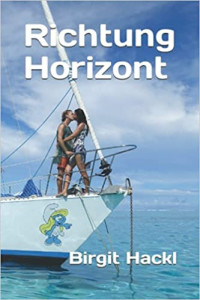In 2024 and 2025 we spent a few months cruising the outer atolls and islands in the NE and N of Papua New Guinea. We were hesitant at first whether we should sail there at all, because of negative reports about crime and harassment of sailors. We were positively surprised to get a very friendly welcome wherever we went, the only complaint the locals had that yachts had stopped visiting their islands (in many places we were the first sailboat after a decade or even 15 years). So I decided to summarise our experiences here and put links to the various blog entries to encourage more cruisers to visit the friendly backyards of PNG!
Note: We did not stop anywhere on the mainland, but reports from other cruisers about assaults and thefts and tales of locals about drunken youth and gang violence, suggest that it’s indeed risky to do so (or you may get lucky and only encounter friendly people like we did when we took trucks up into the highlands in 2005…).
Security
We went shopping in the hardware stores of Fiji and Vanuatu before sailing to the Solomons and PNG and prepped up security measures:
- metal bars over hatches
- motion sensors with solar lights on the radar arch and mast
- a surveillance camera dummy
Once there we removed potentially attractive gear from deck and locked up what was too bulky and had to stay (e.g. we put a wire through jerry cans and the spare anchor and locked them to the railing).
Opportunity makes the thief, so we locked the companionway whenever we left the boat and tried not to leave irresistable goodies (like dive goggles and fins) lying on deck.
We bought a can of pepper spray to fend off intruders, but we were not once harassed by drunk of aggressive locals. Just one time we had fins nicked–we had left them out to dry while we were down in the salon, stupid really. We went to the village chief and got them back within 5 minutes, so no damage done. When you see how few people out there own snorkel gear and how lovingly fins are kept together with all kinds of makeshift repairs when they are already falling apart, you realise how precious these things are and it’s quite understandable that some youth couldn’t resist the temptation.
Saltwater crocodiles
Another big worry were saltwater crocodiles, called pukpuk in PNG. Knowing that we’d spend the super-hot summer there we were horrified that we wouldn’t be able to spend much time in the water. Turns out that the outer atolls are completely croc-free and around the little islands near bigger islands (around Kavieng and in New Hanover) the islanders always just pointed to the “mainland” where they told us that crocs lived in the mangroves, but they assured us that snorkeling out on their reefs was safe. We spent hours in the water each day and enjoyed the wonderful reefs!
Weather and temperature
PNG lies so close to the equator that at least the northern parts are outside the cyclone belt. The temperatures are hot all year round (averages vary from 28°C to 30°C). As we were planning to spend the southern summer in PNG (which is meant to be a very rainy and hot rainy season) we prepared accordingly with shades/rain protection canvas over all hatches. We got some rain in December, but none at all from January to March! Water tanks ashore got empty and the locals told us that the NW winds and rain hadn’t arrived during the previous years either. Climate change…
Of course it was very pleasant to have calm, sunny weather and perfect conditions for snorkeling, so we spent hours in the water every day, but it also meant that we had to witness a severe bleaching event on the otherwise very resilient coral when surface temperatures went up to 31.5°C and even 32°C!
Wind and currents
Looking at predominant winds and cruiser reports we expected SE trade winds until December (and therefore planned to sail quickly up from Vanuatu using those) and NW winds from January to March (which we wanted to use to sail down from Northern PNG via the Solomons to Vanuatu again.
Read the blog entry
The reality was very different: during this la Nina year (but also the previous year, which was el Nino…) the NW winds stayed away from Northern PNG and we had calm weather with short, light breezes from the NE and sometimes E. We therefore couldn’t make as many miles as we had expected westwards (we never made it to the Hermits and Ninigos) and had to be very patient to use the few weather windows to slowly hop back southeastwards during January to March 2025.
Read the full report
What makes sailing towards the SE even more difficult is the fact that a strong current runs northwestwards along the northern side of New Ireland (up to 2 knots).
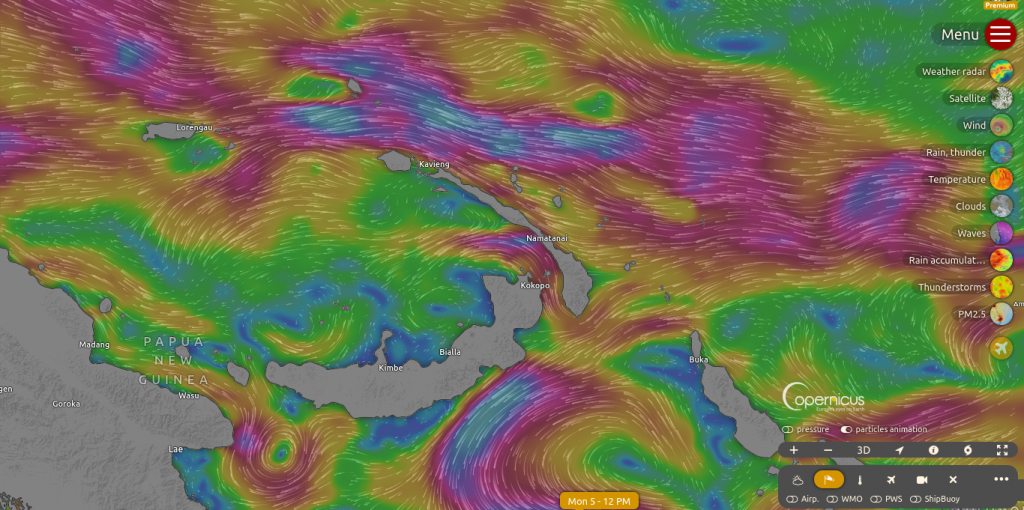
Islands and atolls we visited
I list them not in the order that we went there, but from SE up to NW:
Takuu (Mortlock group)
Takuu is one of the remotest islands of PNG. They have no regular supply ship, a trip with an open boat to the next town (Baku on Bougainville) takes two days (with a stopover in Carteret) and when we there the medical centre was closed as the nurse wasn’t there, so the people are very happy to get basic supplies (rice, sugar, flour, clothes, etc.) and help with medical supplies (disinfectant, antibacterial creams, etc.). They have no cell network and even the sat connection was down when we were there, so the villagers are eager to use Wifi!
Takuu is a Polynesian outlier and they keep up Polynesian traditions and language. The whole population lives on one motu, there’s one garden motu (they only grow coconuts, taro, bananas and papaya–so don’t expect much trading for veg) and all the other islands are full of birds–there’s even one dedicated bird motu with nesting boobies and terns. Snorkeling inside the lagoon was great, most of the eastern side is a no-fishing zone, so leave your speargun (if you have one) aboard. Generally the sandy areas on the lagoon side of the coral shelf are rather narrow, but we found many good anchoring spots.
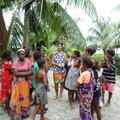
Takuu Atoll, Papua New Guinea
Takuu is one of the remotest atolls of PNG, about 400 islanders of Polynesian descent live there in a rather crowded, dense little village. Another motu is their dedicated garden island and the others are left uninhabited. A pretty place with healthy reefs, seabird motu and incredibly welcoming people! Erosion is gnawing on the shores and the islanders fight it with seawalls, hoping that they will be able to stay on their homeland for a while longer despite the rising sea levels.
(56 photos)
Carteret
Carteret is a Melanesian atoll with hardly any landmass–just 5 tiny motu with one village each. Distances are large, but the people don’t have money for petrol, so all traffic between the islands is done with sailing canoes! Like in Takuu the supply ship calls rarely and people are welcoming and happy to trade, but not much is grown, so bartering is limited to bananas, coconuts and papaya.
We didn’t take Pitufa into the lagoon, but anchored on a sandy spot inside the NW pass. The pass itself was badly bleached, but the outer reef has wonderful coral.
Nuguria
Nuguria is a large atoll with plenty of land, but only two small villages: one next to a pass on the W side and the other one all the way down south. It’s another Polynesian outlier with very friendly people. We stopped briefly at the pass village to say hi and ask for permission to visit the other islands, but spent most of the time on the protected eastern side (we were there in easterly winds) anchored off stunning islands with large seabird colonies.
Snorkeling wasn’t as good as we had expected with many bleached and dead areas on the reefs.
Islands on the N side of New Ireland
We hopped along this chain in daysails and only briefly stayed in each anchorage.
Boang, Tanga Islands
We anchored on a large, sandy patch off the village of Sasa on the S side (calm in NE and E winds) and on the W side in the large bay that looks nicely protected by little motu to the north, but turned out to be very rolly in NE swell. There’s a market in Sasa, but (much to our suprise) hardly any produce to be traded in the little village on the W side. The reefs are badly overfished as the population has “exploded” from 5000 people to 15000 within less than 2 decades…
Lif, Tanga Islands
We anchored on the SE side in the shelter of a large reef and it was calm in N winds and in a light easterly breeze. We had quite a few canoes coming by with adults wanting to trade produce and giggling children who spoke surprisingly little English.
The water’s super clear with a strong current, nevertheless the reef was a disappointment with mostly dead coral.
Lihir
We anchored in the well-protected bay of Palie village (murky water). There’s a supermarket ashore and 3(!) schools, so we had many kids visiting the boat in canoes.
Tabar Islands
We went into the channel between Tatau and Tabar island and anchored in a little bay off a mining exploration post (large building ashore). The miners gave us a friendly welcome, brought out coconuts and papaya and let us use their dock and road up the hill to stretch our legs. A few canoes came by to trade veg and fruit.
Kavieng
We did our e-visa in advance and sent the pre-arrival notifcation ahead. The check-in in Kavieng was then quick and simple: just one stop at the custom’s office and we were done, even got our passports stamped there (no fee). We anchored off Nusa resort and took the dinghy over to town, left it at the dock just south of the market. The vibes in town were friendly, the supermarkets surprisingly well stocked and the market cheap with a good range of veg and fruit (closed Sundays and Mondays).
See full report
Islands off Kavieng
The island maze between Kavieng and New Hanover is worth a visit! Even though the islands are only a short boat ride away from Kavieng the villages are very traditional (and poor) and they are excited to see yachts, as they hardly ever get visitors! In many places we were the first boat in a decade… There are quite a few good anchorages on the northern island chain (e.g. Nusalomon, Lemus), where the water is clear and the crocodile-ridden mangroves of the mainland are far enough away to go snorkeling without worrying about them. Nonovaul is a tricky anchorage (you have to anchor close to the reef), but it’s worth the effort as Sam, the policeman, has been protecting a no-fishing zone for several years in front of his village and you’ll see more big fish than anywhere else in the area. Sam is happy to show you the anchor spot and take you for a snorkel in the Marine Protected Area–please leave a donation to keep him going!
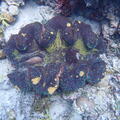
Nonovaul Marina Protected Area (MPA), PNG
Most of the reefs in the Kavieng area are overfished--the demand of a growing population and more and more people selling for money on the market. The people of Nonovaul have declared the reef around their island as a Tambu with restricted fishing and down in the south (in front of the village where it can be policed) they have a permanent no-take zone! Sam, policeman and chairman of the committee, proudly showed us around: huge swarms of parrotfish and a biodiversity and biomass like nowhere else around here :-)
(36 photos)
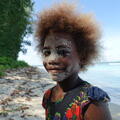
Islands off Kavieng
The maze of Islands between New Ireland and New Hanover is more than just a quick stop-over: friendly villages, beautiful reefs, a few uninhabited islets, calm anchorages and only a few miles between the different destinations :-)
(34 photos)
Islands off New Hanover
We hopped up the island chain off New Hanover on the NE side and anchored off Kulaunus, Tsoilik, Lukus and Nuslik . Everywhere we had excited kids (and adults) coming out in canoes, wanting to trade or just to chat as they hardly ever see sailboats. We then sailed over to Tunung, which is a bit different as Clem has not just established an eco-lodge there and a large no-fishing zone (fees for snorkeling trips), but he’s also trying to do some hands-on development aid for his island as well as raising awareness for ecological issues.
Read more
St. Matthias Islands
We considered stopping in Emirau, but weren’t certain whether we could make it into the anchorage on the W side (retrospectively we’re certain it would have been possible), but went straight to the lagoon between Emananus and Eloaua Island, which looked enticing on sat images–even though we were not certain whether we could make it actually all the way into the lagoon (both Bing and ArcGis images are so brightened up that it looks much shallower than it actually is). Once there we found that the entrance has a few bommies, but is generally about 5 m deep, so no problem. We anchored off the tiny island next to the pass and were suprised to see 1000s of frigate birds coming to rest there every night! People from both islands (Eloaua as well as Emananus are actually pronounced without the E, so Loaua and Mananus)paddled by to welcome us and we visited both main villages. In Loaua the “chairman for tourism” initially tried to ask for a fee for anchoring and snorkeling, but when we explained that sailboats wouldn’t stop there anymore if there was a fee, he quickly changed course and in the end everyone was happy with just having us around to trade and tell stories. We had visitors every day, everyone was eager to trade veg and fruit for clothes, fishing gear, rice, etc.–no wonder as they have no supply ship coming and just a small (expensive) shop on the bigger island Musau.
All villagers are Seventh Day Adventists which makes for great snorkeling: they are not allowed to eat sea animals without scales, so the lagoon and surroundings are teeming with turtles, rays and giant clams. Both islands have established large no-fishing zones–please ask to snorkel there and leave a donation!
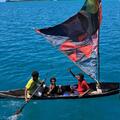
Pics of Eloaua lagoon, St. Matthias Group, Papua New Guinea
Eloaua and Emananus have a shallow lagoon that lies just 90 nm northwest of Kavieng, but hardly any boats make it there. It's a pretty, protected anchorage with great coral outside the lagoon and groups of mantas inside. The locals are friendly, happy to tell stories (PNG for chatting) and eager to trade as supply ships don't call there. We had a steady stream of canoes visiting us!
(28 photos)
Donate
If you find our guides useful you might want to buy us a drink when you meet us somewhere around in person or make a donation to our PayPal account.



